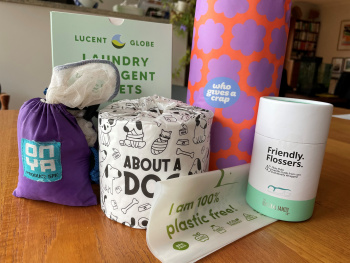Posted by SASTA
on 14/07/2025

By Sue Gaardboe
It was the Plastic Free July website that got me started. It’s true, I was already interested in recycling and composting, but I certainly wasn’t preaching about it or forcing my family to engage in public litter-collecting activities. My early mid-teens children were well aware of the ‘Keep Australia Beautiful’ and ‘Do the Right Thing’ campaigns, but Plastic Free July? Plastic is just …well, it’s just part of everything, right?
The Plastic Free July campaign started in 2011. I saw the website, checked it out, filed it for another day. I let the idea simmer. In 2012 I challenged myself to find one thing that I could change to reduce my consumption of plastic. I needed something that would make a difference, but wouldn’t cause a problem at home. I didn’t want arguments about it. It needed to make an impact – make me aware of my choices – but not disrupt the peace at home. So I started with mesh fruit and veggie bags. I was doing all the shopping, so no problem. When the family were with me I provided them with the bags to use. I made sure there were bags with us at every shopping trip. It became second nature – to me at least.
The following year I decided to take the next step – plastic shopping bags at the check-out were refused, and replaced with re-usable woven bags (available at every check out in major stores). This started to impinge on the family engagement level, as they were required to ensure that shopping bags were in the car before we left home. No bags in the car meant we had to buy another bag as I refused to accept the free plastic bags. The spin-off of this decision was that we no longer had free plastic garbage bags to line the kitchen bin. So that year we also moved to purchasing compostable plastic bags for the garbage bin.
A year (or two) later I was forced to make a change in my buying habits when my favourite peanut butter changed to a plastic bottle instead of its previous glass bottle. Food containers were scrutinized, and honey and mayonnaise brands were also swapped. Oh, and the tea bags! Who knew that tea bags are not just paper fibre, but many also contain plastic! That was a real shock, but easily solved with a little research. The brand swap was deemed acceptable by the tea connoisseurs in the family.
The big problem came when I wanted to avoid buying rolls and rolls of plastic food wrap every year. And when I say big problem, I mean the sort of problem that rumbles in the background, that you just can’t quite solve but can’t ignore either. I had already bought a series of lidded containers so food could safely be stored in the fridge without the need for plastic wrap, but some members of the household just liked using (lots of) plastic film. So I investigated the compostable wrap options - not just biodegradable (that’s a whole other problem), it had to be fully compostable. Fortunately there was a local supplier, but it wasn’t an easy transition. The film was too stiff, didn’t stick well, didn’t tear well… I held my ground. We tried beeswax wraps, alternative brands of compostable wraps, bought more re-usable containers. It must be eight years or so since we converted to compostable wrap, and finally this year a fully compostable (no plastic component to leave micro-plastics), self sticking, easy tearing version has become available. Hooray! Peace has returned to the kitchen.
Government regulations have helped considerably (e.g., single-use bags and straws), but I still have to insist that the deli counter uses a compostable bag from their fresh produce department to encase my olives, rather than wrapping it in cling film. Those bags are perfect for my home composting, and even for use as dog-poo bags (straight into the green bin).
By now I felt I had the kitchen reasonably under control. The bathroom was next to come to my notice, all because of my preferred dental floss holder. I had such a useful plastic handle (re-usable) but the heads that came pre-stretched with dental floss were also plastic, single use and not biodegradable. Thankfully, cornstarch dental floss tools (compostable in commercial systems) are available, so they were a suitable alternative. The shampoo bottle? Solid shampoo (just like a bar of soap) - works well, and is brilliant to travel with.
The toilet paper was next to come under scrutiny. It turns out that toilet paper is a very personal thing. We had been in the habit of buying a particular brand (good value, suitable thickness and tear-strength), but it came in a big plastic bundle. I investigated non-plastic wrapped options. It was a bit like the three bears – this one was too hard, that one was too fragile – finding one in the ‘Goldilocks zone’ (just right) wasn’t so easy. Facebook came to my aid. I followed recommendations for one of the toilet paper subscription companies, and we now not only have toilet paper that’s ‘just right’, but it's also delivered – wrapped in paper, and in a cardboard box.
The demise of the RED Cycle system was a blow, but also further impetus. I realized just how far I still had to go as the soft plastics we were still being bombarded with multiplied in the shed. I still haven’t worked out what to do with all the little things that come in a bag, which is put in a second bag before being boxed, and then wrapped in plastic! If the cost of plastic was a bigger factor, I’m sure the suppliers would re-consider their excessively generous use of this resource.
Single-use bottles (dishwashing liquid and cleaning products) are on my radar, but the re-filling process is messy and my favourite products aren’t available. I’m also no longer in charge of the shopping, but grateful that my purchasing-partner has accepted the need to make plastic free choices, and he does what he can – even accepting detergent sheets for washing the clothes!
My journey to de-plastic our house has a long way to go. Taking it one step at a time – changing just one thing – is working for us. By waiting until the dust died down before looking around for the next thing, I gave my family time to acclimatize and be on-board for the next step in the journey. And it turns out that they’ve been taking notice, as evidenced by the plastic free choices I see them implementing in their own homes, now with their own families. Changing just one thing might not seem like it will solve the problem of plastics in our world, but before you know it that one change has become many, and it’s no longer just you, doing it alone. What’s the one thing you could change today?
Dr Sue Gaardboe
I’m a primary school teacher with a passion for the environment (including my garden, dogs and chickens), and a keen interest in science. I’m now working in the Department for Education, implementing a program introducing Problem-Based Learning in primary schools, with industry partners providing a problem for students to investigate.
In this Section
Archive
- December 2025
- November 2025
- October 2025
- September 2025
- August 2025
- July 2025
- June 2025
- May 2025
- April 2025
- March 2025
- February 2025
- January 2025
- December 2024
- November 2024
- October 2024
- September 2024
- August 2024
- July 2024
- June 2024
- May 2024
- April 2024
- March 2024
- February 2024
- December 2023
- November 2023
- October 2023
- September 2023
- July 2023
- June 2023
- May 2023
- April 2023
- March 2023
- February 2023
- January 2023
- December 2022
- November 2022
- October 2022
- August 2022
- July 2022
- June 2022
- May 2022
- April 2022
- March 2022
- February 2022
- January 2022
- December 2021
- November 2021
- October 2021
- September 2021
- August 2021
- July 2021
- June 2021
- May 2021
- April 2021
- March 2021
- February 2021
- January 2021
- December 2020
- November 2020
- October 2020
- September 2020
- August 2020
- July 2020
- June 2020
- May 2020
- April 2020
- October 2018
- September 2018
- August 2018
- July 2018

